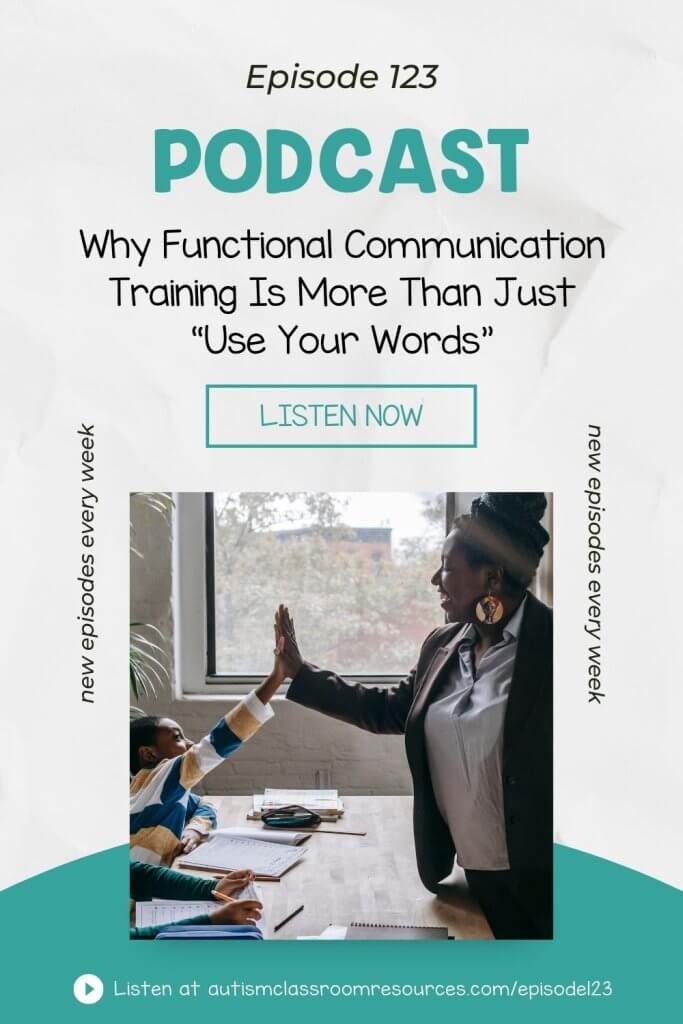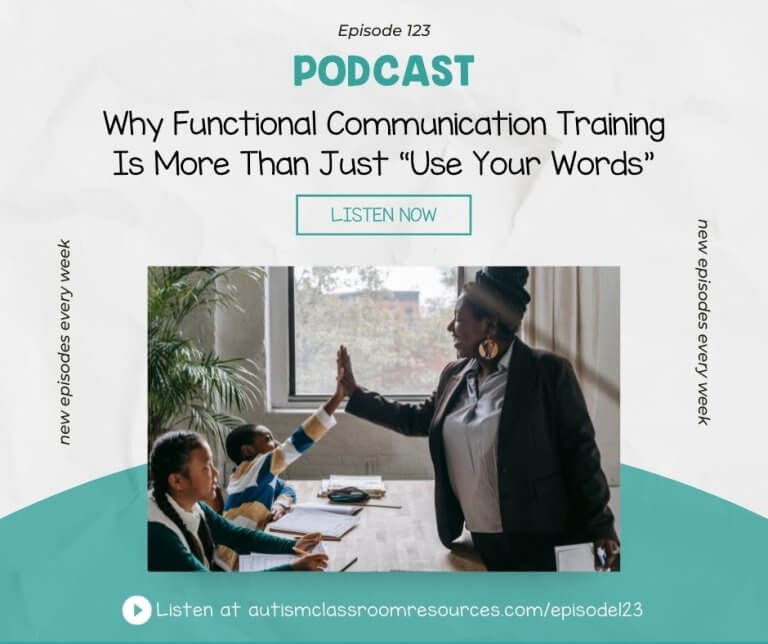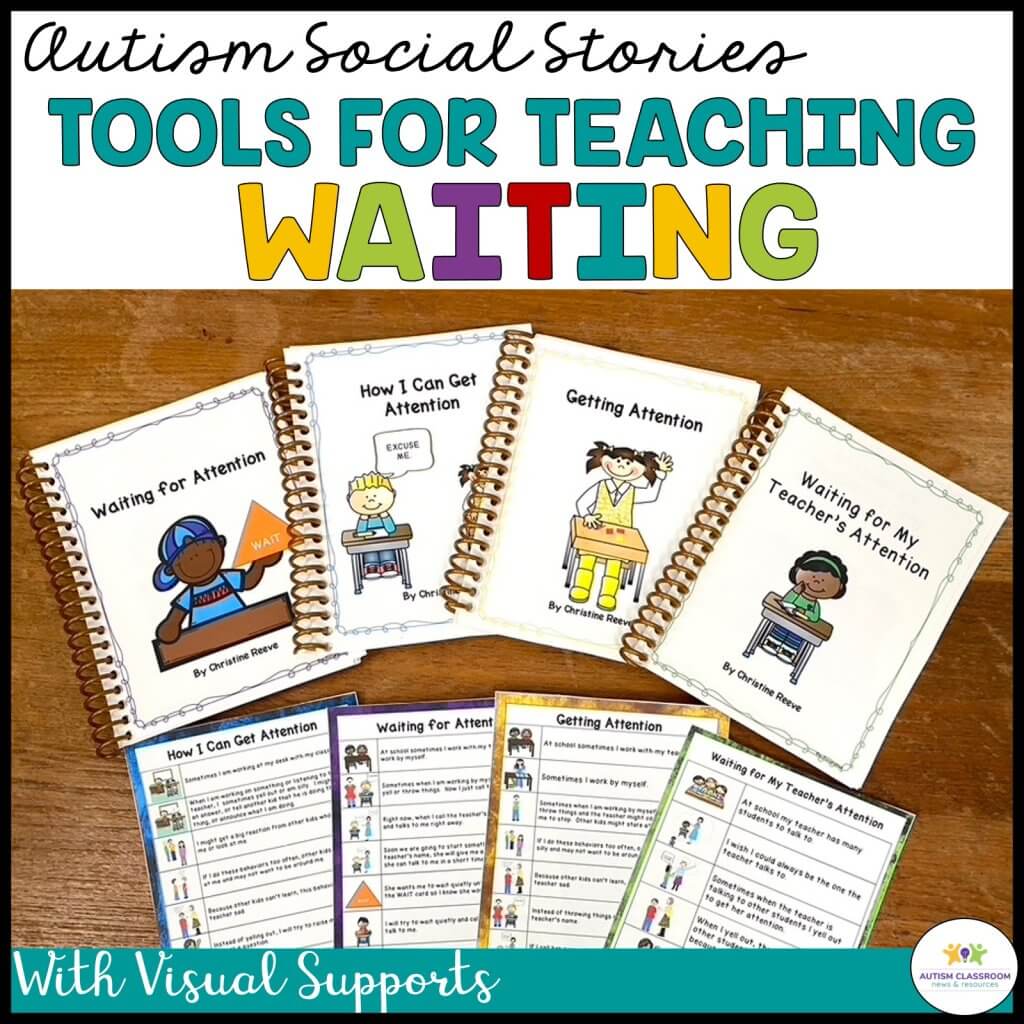Welcome to the Autism Classroom Resources Podcast, the podcast for special educators who are looking for personal and professional development.
Christine Reeve: I’m your host, Dr. Christine Reeve. For more than 20 years, I’ve worn lots of hats in special education but my real love is helping special educators like you. This podcast will give you tips and ways to implement research-based practices in a practical way in your classroom to make your job easier and more effective.
Welcome back to the Autism Classroom Resources Podcast. Hello, I’m Christine Reeve. I am so glad you’re joining me as we’re talking about the relationship between communication and behavior during May. Last week, I talked about Positive Behavioral Support. A big piece of Positive Behavioral Support is the focus on communication skills as a replacement skill for challenging behavior.
We know from our functional assessment research that many behaviors serve a social communicative function. I talked about that in Episode 121. That is, they work to communicate something to those around them. They can be functionally replaced with more appropriate communication skills. Now, for many of our students with autism and developmental disabilities, they develop challenging behaviors in part because their communication skills don’t develop to serve the functions that typically replace normal developmental behaviors that we see in younger children.
For them, and for some other children who have those communication skills, the challenging behaviors pay off. They’re easier. The more reliably getting that need met, then the communication skills are and so they persist.
Consequently, when we set about to replace the problem behavior with communication skills, many times I see people saying it’s as easy as just instructing the students to “use their words”. “Just use your words,” we see parents say that all the time. For little kids that might be enough but for our students with their challenging behaviors, and the habit that has built up around their challenging behaviors, it’s not. In reality, it’s a good bit more complicated than that. It really does take some thought and some planning to make it work. That’s what I’m going to talk about today.
I’m going to talk about the process of teaching communication skills to replace challenging behavior, which we call Functional Communication Training. I want to share how it can be hugely effective and work really well in the classroom when we do it right.
Now, clearly, I can’t teach you everything about it in a podcast. If you want to know more about FCT and Functional Behavior Assessment—which you need in order to do it—and how to figure out behavior in general, we have a whole course on behavioral problem solving. We have workshops on Functional Communication Training and a ton more of strategies, tips, and timesavers in the Special Educator Academy. You can join for a seven-day trial and see if it’s for you. Then if you stay on, you get a free 15-minute consultation with me to help plan a personal path for you to build your professional development to help you be more confident, save you time, and stress in your job. You can find out more at specialeducatoracademy.com. Now, let’s get started.
The first step in Functional Communication Training is that we have to know the function of the behavior. In order to know what communication strategy we’re going to use, we need to do a Functional Behavior Assessment. We know that teaching the communication skill can be important but knowing what communication skill to teach is going to depend on what the function of the behavior is. Doing that FBA first is a critical first component. Once we know is the behavior to get attention—is it to escape from something? I generally will talk about the fact that you really want a hypothesis statement that’s very specific, escape from what? In what situation? Whose attention? What kind of attention? The more that you know, the more you’re going to have a better communication skill to replace it with.
The next step is trying to decide what the communication form you’re going to teach is going to look like. That might be the single biggest decision that you’re going to make in your Functional Communication Training. Horner & Day in ‘91 talked about response efficiency. That is something that is really critical in choosing your communication form or any replacement behavior. The efficiency of the form is how quickly, how easily, and how consistently your form of communication gets reinforced and meets that need. Those are your three questions that you need to answer when you choose your form of communication.
You have to think about how easy it is versus how available it is. For instance, sign language is very available. I have my hands with me all the time. I say as I sit no one watches me doing my jazz hands because I do them on a train. I have them with me. They’re always on me. They are pretty easy. They aren’t always interpretable to all the audiences. In addition, I may not be very good at my signs. My signs might not always look right to people who know sign language because maybe my fine motor skills aren’t that great. Maybe they aren’t as easy as we thought they were. You have to think about that. Maybe they’re available but they’re not always as easy or interpretable as we thought so they might not be as efficient.
If I always have my communication book or my communication device with me, it could be just as available and people understand it better. We have to think about signs, pictures. One thing I will say is, even if the student is verbal, I will always choose to start with a communication form that I can manually prompt. The student will very rapidly move to something that’s easier like voice, like saying something because that is the most available and easy thing. If it’s not easy, he will not use it. If there is a vocal issue, then he’s never going to move to that. He’s not going to move to that because it’s not easy. If he doesn’t move to it, it’s not easy.
But I have to be able to manually prompt it so that I can make it happen, so he can see the connections, so we can get to the reinforcer. He will fade that out over time if he can’t. The most efficient communication system is what’s going to win out. Some guidelines: Choose something the student can already do. He’s got communication strategies already, choose that. The one exception being if he can talk, still use a manually preemptable strategy like giving you a picture. Because you can prompt that, you can’t prompt verbal. Choose something that can be acquired quickly if he has no communication strategies at all.
Again, use a switch that has a voice. Use a picture he can exchange. Something this easy to use has been shown to be most effective. Something that gets reinforcement reliably. You want to make sure it gets reinforcement every single time. That’s where that interpretability becomes really important. You want something that is easily interpretable because that increases generalization of who he can use this with.
You also want something that doesn’t have a negative learning history. I have worked with some students that have past histories where people have tried to do this. They’ve used something that maybe I would typically use. I often use asking for break as an escape response. I had a student that was doing that but when they were doing it, they were having him ask for a break and he was a very attention seeking kid who also had a difficult time with hard work but difficult tasks. So he had escaped and attention functions. But every time that he asked for a break, it was a timeout, essentially, which was not appealing to him. That was not reinforcing.
Essentially, they were upset because he was like, “Functional Communication Training isn’t working for him.” I’m like, “No, it’s not because it’s a punishment. You’re isolating him when he asked for a break. That’s not the kind of break he wants.” You’ve always got to make sure that your responses is reinforcing even if it is technically meeting the function. The problem was that asking for a break had been associated with this negative learning history. I was never going to get him to ask for a break because that had been associated with something he didn’t like. It had been associated with something that to him was punishing.
We had to use something else. I was tired. I racked my brain and I didn’t know what to do with him. I finally just said, “I don’t want to.” We’re just going to use, “I don’t want to. I know you don’t like it. I don’t like it either. But it’s clear. Everyone understands that. We’ll start with that.”
Those teachers eventually got him to saying, “No, thank you,” which they liked much more and he was good with that. But we started with “I don’t want to”. Actually, maybe it even started with just “No”. I don’t use that very often because people don’t like it. They tend to ignore it. So you want to choose something that people will respond to which is why use, “I need a break.” That implies that I’m going to come back to this. That’s why I’ve chosen that, but anyway, don’t use something that people have used before, then pair it with something they don’t like. Just avoid that.
Choose a form that can serve as something that will be generalized when they’re with new people. New people are going to understand what it means and they’re going to be likely to respond to it. We do have evidence that shows that outside the training environment, pictures are going to be more responded to than sign language because people understand them faster and easier. You just want to think about the environments the person is going to interact with. Generally, I would start simple and move to more complex. Start with something really easy. That’s why I start with manually prompted ones.
Then you want to set up your instruction. I generally will start in a smaller environment where I can control more variables. I would start in a situation where it might be you and maybe one other peer—depending on the situation—start in a situation where you can set it up to be a situation where he’s likely to have a problem behavior but you can control it because you’re going to set up the situation where the behavior often happens. You don’t want to have it in a big crowded area. You want to have it where it’s not going to disturb other kids but I try to keep it as close to the natural environment as I can. But I don’t want to set it up where it’s going to be a negative experience for everybody.
Then we practice and I reinforce it. If it’s an attention seeking behavior, I might say, “You do your work and I’m going to do mine.” I turned to mine and I say, “Okay, I’m doing my work.” Then I immediately prompt him to ask for attention. Then I attend to him immediately. We do that over and over until he can independently make that request on his own. Then I can start to work in delays. Then when he could do it with me, then we start to move into larger environments. But we start in a more secluded session before we start moving into larger environments. I don’t make the reinforcer available everywhere until we get it in that smaller session.
Now, you may find that you can move really quickly out into a larger situation. But the problem is if you move into a larger situation, and you don’t have the staffing or the support to be able to reinforce it in that situation where I can really pay attention to him when he asked for attention or give him a break would ask for a break, then I’m going to undermine my instruction. He’s going to learn in that setting this doesn’t work. You’re going to have to unteach that later. I’d rather start it just contained. Get it going, get it strong, and then move it out.
The biggest key is the practice. Think of it as strength training where we need to do our reps. We’ve got to practice over and over until it becomes a habit. The habit is also a good analogy. When you think about training, think about the fact that you have to move those weights 30 times, two sets of 15 reps. Same kind of thing when you’re trying to deal with a bad habit, you have to really focus on it. You have to practice it over and over. It doesn’t happen overnight. You’ve got to have multiple sessions where you’re practicing it multiple times.
In addition to practice, we have to do it consistently. I set up a couple times a day, maybe 5 or 10-minute sessions where we practice this. This is the time that we just work on this skill. This is what we’re working on. I write an IEP goal for it. This is what we focus on. We’re working consistently on this. Once he gets it then we can start to expand it.
As we move through the teaching, we want to make sure that we’re boosting up the reinforcement for the communication skill and making the problem behavior really inefficient at getting the function meeting getting reinforcement. We make the communication form really efficient by getting that reinforcement fast, easily, and consistently. We create a similar condition where we try to make the challenging behavior really slow at getting reinforcement, where the individual has to work extra hard to get reinforced or get that outcome for the challenging behavior, where it just doesn’t pay off as often or as consistently.
To some degree, this means that we ignore it. If it’s an attention seeking behavior if we can, we let the person out of the situation if it’s an escape related behavior as little as possible. But there is some indication that indicates we don’t have to use perfect extinction processes. We don’t have to always ignore it. We just have to delay the reinforcement, make it less consistent. That means that we don’t have to let the behavior continue forever. It means that we don’t have to let it overtake our class.
There are times that it’s going to make more sense just to give in and move on rather than have the behavior escalate and ending up having to give in when the behavior is more significant. That’s a talk for a whole different day in terms of responding to behavior. That’s something much more complex, but essentially, you want to make the behavior really efficient and efficient at getting the reinforcement.
Then once the student is independently making those requests and the challenge behaviors have decreased, then we can start building in some demands for working a little bit at a time. We can start working on some delays, teaching the student how to wait for attention a little bit at a time, and I’m talking a little teeny tiny like five seconds, two seconds delay. Put one piece of the puzzle in and do one part of the file folder, one piece. Do one math problem and then slowly increase again. That’s kind of the next stage of that. We did that very slowly. Sometimes students do it on their own. Once they know that they have a way to get that need met, they don’t need us to help them with that.
Now, as I said—I’ve gone on long enough—there’s so much more that goes into FCT, but by essentially teaching the communication responses that serve the function of the behavior, we’re giving our students a lifelong skill that can serve to improve their quality of life without the need for challenging behavior. We’re really doing a double service. We’re increasing and teaching while we’re eliminating barriers for them. That’s a huge, huge thing. I have a couple of toolkits in my TPT store that focus on helping students to learn these types of skills. One has tools for teaching students how to request attention and then how to learn to wait. The other has tools to learn how to ask for a break and remain calm once they have it.
They each have protocols for teaching the specific communication skills within them, as well as visuals and social stories to help them understand the expectations. I’ll make sure to include links to them in the post for this episode. You can find them and a transcript at autismclassroomresources.com/episode123. We have a whole workshop on the research and steps of FCT in the Special Educator Academy as well. Come join us there at specialeducatoracademy.com. Thanks so much for joining me this week in this slightly longer than normal episode. I hope you have an incredible week in your classroom this week. Then I’ll see you again back here next time.




![TOOLS FOR TEACHING SELF-REGULATION [SOCIAL NARRATIVES AND VISUAL SUPPORTS]](https://autismclassroomresources.com/wp-content/uploads/2020/06/calm-down-cover-1024x1024.jpg)




